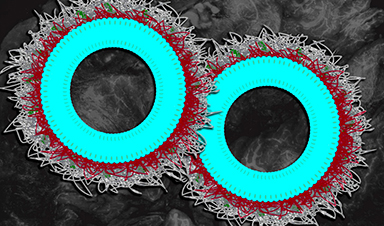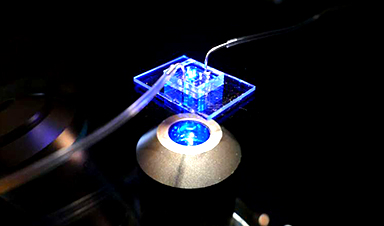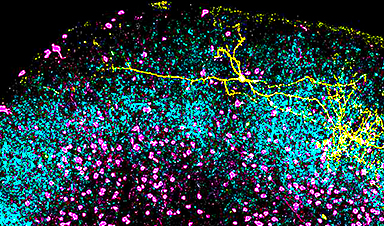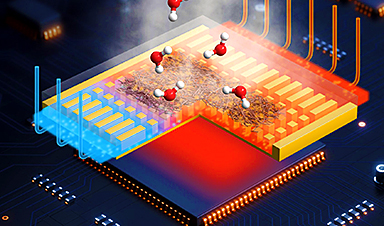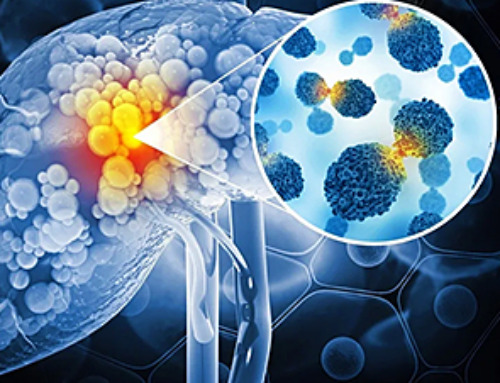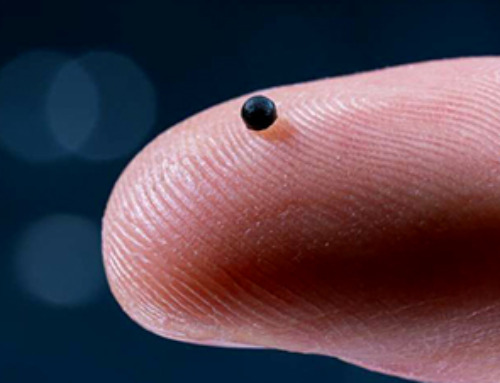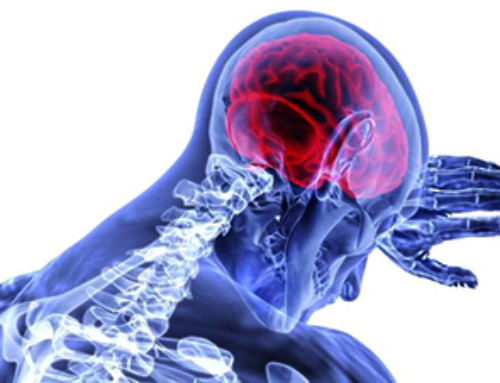With the advent of Big Data, current computational architectures are proving to be insufficient. Difficulties in decreasing transistors’ size, large power consumption and limited operating speeds make neuromorphic computing a promising alternative.
In a recent publication, scientists from the Universitat Autònoma de Barcelona (UAB), the CNR-SPIN (Italy), the Catalan Institute of Nanoscience and Nanotechnology (ICN2), the Institute of Micro and Nanotechnology (IMN-CNM-CSIC) and the ALBA Synchrotron have explored the emulation of artificial synapses using new advanced material devices. The project was led by Serra Húnter Fellow Enric Menéndez and ICREA researcher Jordi Sort, both at the Department of Physics of the UAB, and is part of Sofia Martins Ph.D. thesis.
A new approach to mimic synapse functions
Until now, most systems used for this purpose were ultimately controlled by electric currents, involving significant energy loss by heat dissipation. Here, researchers’ proposal was to use magneto-ionics, the non-volatile control of the magnetic properties of materials by voltage-driven ion migration, which drastically decreases power consumption and makes data storage energy-efficient.
Although heat dissipation decreases with ion migration effects, magneto-ionic motion of oxygen at room temperature is usually slow for industrial applications, involving several seconds or even minutes to toggle the magnetic state. To solve this problem, the team investigated the use of target materials whose crystal structure already contained the ions to be transported. Such magneto-ionic targets can undergo fully reversible transformations from a non-ferromagnetic (switched OFF) state to a ferromagnetic (switched ON) state and vice-versa just by the voltage-driven oxygen motion from the target towards a reservoir (ON) and vice-versa (OFF).
Given their crystalline structures, cobalt oxides were the chosen materials for the fabrication of the films, ranging from 5nm to 230nm thick. The researchers investigated the role of thickness on the resulting magneto-ionic behavior, revealing that the thinner the films, the faster the generation of magnetization was reached.
X-ray absorption spectra (XAS) of the samples were performed at the BOREAS beamline of the ALBA Synchrotron. XAS was used to characterize, at room temperature, the elemental composition and oxidation state of the cobalt oxide films, which resulted as different for the thinner and thickest films. These findings were crucial for understanding the differences in the magneto-ionic motion of oxygen between the films.
As the operating speeds achieved in this work were similar to the ones used for neuromorphic computing, the thinnest cobalt oxide films were further investigated. In particular, the effects related to learning neuromorphic capabilities were induced and results provided evidence that magneto-ionic systems can emulate “learning” and “forgetting” functionalities.
In addition to neuromorphic computing, other practical applications such as magnetic memories and spintronics will benefit from the results of this study. The combination of magnetic memories with energy-efficient magneto-ionics could be a possible way to reduce the operational energies for next-generation data storage media, while magneto-ionic mechanisms to control antiferromagnetic layers are currently promising candidates for the development of spintronic devices.
News
Vision can be rebooted in adults with amblyopia, study suggests
Temporarily anesthetizing the retina briefly reverts the activity of the visual system to that observed in early development and enables growth of responses to the amblyopic eye, new research shows. In the common vision [...]
Ultrasound-activated Nanoparticles Kill Liver Cancer and Activate Immune System
A new ultrasound-guided nanotherapy wipes out liver tumors while training the immune system to keep them from coming back. The study, published in Nano Today, introduces a biodegradable nanoparticle system that combines sonodynamic therapy and cell [...]
Magnetic nanoparticles that successfully navigate complex blood vessels may be ready for clinical trials
Every year, 12 million people worldwide suffer a stroke; many die or are permanently impaired. Currently, drugs are administered to dissolve the thrombus that blocks the blood vessel. These drugs spread throughout the entire [...]
Reviving Exhausted T Cells Sparks Powerful Cancer Tumor Elimination
Scientists have discovered how tumors secretly drain the energy from T cells—the immune system’s main cancer fighters—and how blocking that process can bring them back to life. The team found that cancer cells use [...]
Very low LDL-cholesterol correlates to fewer heart problems after stroke
Brigham and Women's Hospital's TIMI Study Group reports that in patients with prior ischemic stroke, very low achieved LDL-cholesterol correlated with fewer major adverse cardiovascular events and fewer recurrent strokes, without an apparent increase [...]
“Great Unified Microscope” Reveals Hidden Micro and Nano Worlds Inside Living Cells
University of Tokyo researchers have created a powerful new microscope that captures both forward- and back-scattered light at once, letting scientists see everything from large cell structures to tiny nanoscale particles in a single shot. Researchers [...]
Breakthrough Alzheimer’s Drug Has a Hidden Problem
Researchers in Japan found that although the Alzheimer’s drug lecanemab successfully removes amyloid plaques from the brain, it does not restore the brain’s waste-clearing system within the first few months of treatment. The study suggests that [...]
Concerning New Research Reveals Colon Cancer Is Skyrocketing in Adults Under 50
Colorectal cancer is striking younger adults at alarming rates, driven by lifestyle and genetic factors. Colorectal cancer (CRC) develops when abnormal cells grow uncontrollably in the colon or rectum, forming tumors that can eventually [...]
Scientists Discover a Natural, Non-Addictive Way To Block Pain That Could Replace Opioids
Scientists have discovered that the body can naturally dull pain through its own localized “benzodiazepine-like” peptides. A groundbreaking study led by a University of Leeds scientist has unveiled new insights into how the body manages pain, [...]
GLP-1 Drugs Like Ozempic Work, but New Research Reveals a Major Catch
Three new Cochrane reviews find evidence that GLP-1 drugs lead to clinically meaningful weight loss, though industry-funded studies raise concerns. Three new reviews from Cochrane have found that GLP-1 medications can lead to significant [...]
How a Palm-Sized Laser Could Change Medicine and Manufacturing
Researchers have developed an innovative and versatile system designed for a new generation of short-pulse lasers. Lasers that produce extremely short bursts of light are known for their remarkable precision, making them indispensable tools [...]
New nanoparticles stimulate the immune system to attack ovarian tumors
Cancer immunotherapy, which uses drugs that stimulate the body’s immune cells to attack tumors, is a promising approach to treating many types of cancer. However, it doesn’t work well for some tumors, including ovarian [...]
New Drug Kills Cancer 20,000x More Effectively With No Detectable Side Effects
By restructuring a common chemotherapy drug, scientists increased its potency by 20,000 times. In a significant step forward for cancer therapy, researchers at Northwestern University have redesigned the molecular structure of a well-known chemotherapy drug, greatly [...]
Lipid nanoparticles discovered that can deliver mRNA directly into heart muscle cells
Cardiovascular disease continues to be the leading cause of death worldwide. But advances in heart-failure therapeutics have stalled, largely due to the difficulty of delivering treatments at the cellular level. Now, a UC Berkeley-led [...]
The basic mechanisms of visual attention emerged over 500 million years ago, study suggests
The brain does not need its sophisticated cortex to interpret the visual world. A new study published in PLOS Biology demonstrates that a much older structure, the superior colliculus, contains the necessary circuitry to perform the [...]
AI Is Overheating. This New Technology Could Be the Fix
Engineers have developed a passive evaporative cooling membrane that dramatically improves heat removal for electronics and data centers Engineers at the University of California San Diego have created an innovative cooling system designed to greatly enhance [...]












